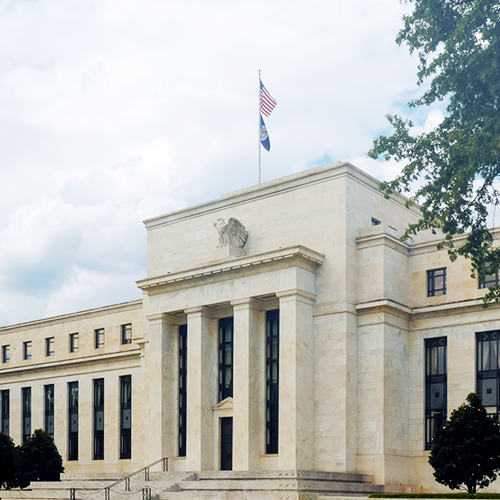
July 2025
The Banking Sector’s Makeover
Ivor Schucking, head of credit for Aristotle Pacific, explains why he believes regulators have finally won the decades-long battle to de-risk the global banking system.
Download PDFWe recently sat down with Ivor Schucking, head of credit for Aristotle Pacific Capital, to get his insights into the health of the banking sector, including three decades of reforms that have appeared to heal a once-troubled industry.
You’ve spent most of your career analyzing the banking sector. What is it about banks that gets you out of bed each day?
As an analyst for more than three decades, I’ve enjoyed researching an industry that has great relevance to the economy and investment markets. I can’t think of any industry that provides a better window into the economy. Just look at what happened during the Global Financial Crisis—the banking sector took down the global economy. Governments that rescued their banks lost on average 5% of their GDP, and they increased their debt by an average of 20%. In addition, much of the debt that governments have taken on since the Global Financial Crisis has been related to banking system bailouts. It all fascinates me.
Let’s go back three decades. What were the problems with international banks and how they function then?
I started my career over 30 years ago, and prior to that, I went to New York University Business School, where about 10% of the student body in the early 1990s were Japanese. And that was not an accident because 16 of the 25 largest banks in the world then were Japanese. And all those banks eventually failed, causing the entire Japanese economy and banking system to be restructured. That hurt the Japanese economy for more than 20 years. Those banks and many others around the globe were growing basically without safeguards.
U.S. Bank Earnings Elevated at Near-Record Levels

What lessons were learned from the Japanese banking crisis?
The Japanese banks decided to ignore reality, and hope and pray real estate prices would get better so the banks could sell their bad loans. That response provided a textbook example to every banking system in the world about what not to do. In fact, U.S. regulators learned that when the U.S. banks had their problems during the Global Financial Crisis, the most important governmental response was to overshoot immediately. For the U.S. that included increasing bank capital through the Troubled Asset Relief Program (TARP) and instituting stress tests. What we learned is the faster and stronger the response to banking crises, the shorter and less severe the economic harm. What’s different about banking compared to any other industry is that confidence matters. Banks cannot have enough capital—if everyone thinks they’re in trouble and their counterparties stop doing business with them, it’s one of the few industries where you will fail. Confidence is oxygen to the banks.
So, in life and in banking, take your medicine. Is that what I’m hearing?
Yes. Don’t postpone the inevitable. There’s a great quote: “Procrastination makes an easy problem hard and a hard problem impossible.” I think that applies to banking problems.
How did regulators start to reform the banks’ business model?
It started in 1988 with the first Basel Accords, which required banks to have, among other things, higher capital ratios. The Basel Accords have been revised twice since then—in 2004 and 2010—adding more and tougher international regulations.
But even with the Basel Accords, we still experienced the Global Financial Crisis. What went wrong?
The initial Basel Accords set minimum capital standards, but they were very simplistic. I’m sure it’s no surprise to anyone that banks can be quite creative, and at the time they were still being rewarded for getting bigger. So, they found a way. From the banks’ standpoint, their incentives were very much equity focused—grow, become more diversified, scale is rewarded. And they did grow like crazy. But we’ve learned that this business model—which I argue resembled a casino’s—didn’t work. The regulators were asleep. I think it’s important to note that all stakeholders got burned by the old business model. If you were a bank management team, a taxpayer, the head of a country, an employee of a bank, a rating agency, or a regulator, the old business model failed you.
How was this fixed?
Bank regulators totally revamped the regulatory framework by instituting a couple of key features. First, the banks needed to increase capital and increase liquidity. Next, the banks needed to get out of non-core businesses with the idea that the bank business model would need to become simpler, safer, and stronger. If you compare the banks today to the Global Financial Crisis, they have significantly more liquidity and capital. They also have four times as much liquidity. Basically, the banks were forced to become much more conservative, and their loan books look incredibly different today. The banks have sacrificed their margins to some degree, but it’s for a much less risky customer than they had before.
Bank of America Balance-Sheet Transformation

What has changed since the Global Financial Crisis?
When you looked at the old bank business model, you had an industry that had been woefully undercapitalized with very low levels of liquidity. The business model was based on growth and size. The banks were rewarded for becoming bigger. The idea was the bigger the bank, the higher the stock price, the higher the credit rating, and the lower the funding costs. The view was that all these acquisitions were positive, and they would be beneficial to your share price. Now we know that the best indicator of a bank’s future collapse is excessive growth. And when I say excessive growth, what I'm referring to is mispriced risk. That is your single best indicator of future trouble. And it’s important to note that for a long time, banks knew they had an out: the taxpayer who would be on the hook for any bailout. The incentives and rewards were very much aligned with taking as much risk as possible.
Can you give me a sense of how risky you consider the bank business model was 30 years ago versus today?
It’s something akin to driving down the freeway. Three decades ago, you had no speed limit. You could drive at unlimited speeds on bad roads. There were very few police, and they’re not necessarily enforcing the law. As a result, you had a lot of accidents. In the end, there was no accountability, and the banks got bailed out by the government. Today, the banks are driving down the highway at a very low speed and good roads. Plus, you have a lot of police officers on the beat in addition to cameras everywhere. And if you get caught speeding, you receive significant fines.
Is the feature of excess capital specific just to the U.S. or is it a global phenomenon?
I think it’s important to note that in the U.S., only 13 banks—those who have over $250 billion in assets—have extremely high regulation. In Europe, it’s far different. The European banks are much more important players in their financial system. They tend to be a lot bigger than their U.S. counterparts, and they tend to have very little competition from the non-banks and play a large role in the financial life of individuals. For example, the average person in Europe keeps 70% of his or her financial assets at a bank. In the U.S., that figure is 20%. Not surprisingly, with European banks being so large and having such a dominant role in their financial systems, any bank with over $30 billion of assets (versus $250 billion for U.S. banks), gets heavily regulated. That translates into 111 banks in Europe, which has resulted in even more excess capital and higher capital ratios than their U.S. counterparts.
What about Chinese banks?
The Chinese banking system right now is twice the U.S. banking system. They’re the only banking system in the world that has been growing rapidly in the past few decades. And I would argue that if you look at the Chinese banks and their relationship with their economy, it’s been very hard for the Chinese economy to grow simply because the banks themselves are dealing with asset-quality problems. It’s the one banking sector that has not followed the global regulatory playbook that we’ve seen successfully enacted in the U.S. and Europe.
On a scale of one to 10, how effective do you think these new regulations have been?
Overall, I’d give them an eight out of 10. But I would say there are two parts to bank regulation. First, the rules. Bank regulators have figured out a good set of rulemaking to align the regulator’s interests and goals with the creditors. That part I’d score a nine out of 10. But when it comes to the actual enforcement, I think we still have some problems. I’d score that a seven.
Have there been any unintended consequences from these reforms?
First, the intended consequences have worked. The banks have effectively slowed the growth of their loans, which is very important to limit credit risk, and made less risky loans. The banks have sought stronger borrowers and shifted from unsecured loans to secured loans. In contrast, the reforms have helped fuel private credit’s rapid growth in recent years. It’s taken market share away from the banks. This part of the financial ecosystem hasn’t been fully tested, but I think that’s where much of the credit risk has migrated.
The Growth of Nonbank Financial Institutions Since 2007

Do you think that private credit will present challenges for the U.S. and global economy in the future?
I would argue that is the most relevant question. If you were to ask any banker what worries them, number one would be the economy. Banks are levered to the economies they operate in. Number two would be cybersecurity. It’s something every banker around the world is concerned about. And number three would be private credit. I do believe this is the area with the most question marks.
Advocates of private credit argue the investments are mostly sound investments, the money comes from wealthy investors, and most of the money is locked up for several years, so it’s not at immediate risk in the event of a liquidity crisis. So, it’s safe to say the private equity business model is unlike those of banks, but at the end of the day, there’s no ignoring the risk. Whenever I’m thinking about an economic downturn and the inevitable rising credit problems, I would first look at the private credit space.
Given the fact that riskier borrowers have moved to private credit, is that really a blessing in disguise for big banks?
Banks are making more conservative loans with lower margins. However, they’ve also been able to increase their fee income. Private credit players, who have been quite successful in the past decade, also have to borrow money. So, the banks provide bank lines to them. And in addition, the banks have started partnering up with several of these players. They have joint ventures, and the banks earn fees from these relationships. I would argue the banks have found a way to recognize they have multiple relationships with private equity firms. It’s a complicated relationship, but the banks have done quite well with a mix of lending money to these players and also earning fees from them.
How does the shift in global bank models impact how you look at bank bonds?
I think banking ratings have never been more conservative than they are today. We have a very simple philosophy in choosing banks, and here’s the analogy I use. I’d rather buy a barn in Beverly Hills than a chateau in some spot no one wants to live. So, I’m trying to find a very good neighborhood—for example, a very good country. The strategy is to find quality and then look for value. Think about choosing a school for your child. You probably don’t look for the cheapest school; you look for the best schools. And then you try to figure out what can you afford and what’s the best value. And that’s like choosing bank bonds. You want to find the strongest banks in the lowest risk countries. Let’s say there are 25low-risk countries, which means we’re looking at about 75 banks globally. You have lots of opportunities to find mis-rated securities and securities that potentially provide value.
Bank liquidity refers to a bank's capacity to meet its financial obligations, specifically its ability to convert assets into cash or access readily available funds to cover liabilities like withdrawals, loan demands, and other expenses, without incurring unacceptable losses.
Banking ratings are assessments of a financial institution's safety and soundness, indicating its ability to meet its financial obligations.
The Basel Accords are a series of international banking regulations, primarily focused on capital requirements and risk management, established by the Basel Committee on Banking Supervision.
A capital ratio is a financial metric that compares a company's or bank's capital to its assets or risk-weighted assets, indicating its financial health and ability to absorb potential losses.
The Global Financial Crisis (GFC) refers to the period of extreme stress in global financial markets and banking systems between mid-2007 and early 2009.
Gross Domestic Product (GDP) is the total monetary or market value of all the finished goods and services produced within a country's borders in a specific time period.
Margin or profit margin is a financial ratio that expresses a company's profitability as a percentage of its revenue.
Net income is the total profit or earnings of an individual or business after all expenses, taxes, and other deductions are subtracted from gross income or revenue.
Private credit refers to loans provided by non-bank lenders to companies, distinct from traditional bank loans or publicly traded debt.
Private equity (PE) refers to investments in companies that are not publicly traded on a stock exchange.
Return on Assets (ROA) is a financial ratio that measures how effectively a company uses its assets to generate profit. It indicates how much profit a company earns for each dollar of assets it owns.
Stress testing in banking is a risk management tool that evaluates a bank's ability to withstand adverse economic conditions or crises.
The Troubled Asset Relief Program (TARP) was a U.S. government program created in 2008 to stabilize the financial system during the financial crisis.
Any performance data quoted represent past performance, which does not guarantee future results. Index performance is not indicative of any fund’s performance. Indexes are unmanaged and it is not possible to invest directly in an index. For current standardized performance of the funds, please visit www.AristotleFunds.com.
The views expressed are as of the publication date and are presented for informational purposes only. These views should not be considered as investment advice, an endorsement of any security, mutual fund, sector or index, or to predict performance of any investment or market. Any forward-looking statements are not guaranteed. All material is compiled from sources believed to be reliable, but accuracy cannot be guaranteed. The opinions expressed herein are subject to change without notice as market and other conditions warrant.
Investors should consider a fund’s investment goal, risk, charges and expenses carefully before investing. The prospectus contains this and other information about the fund and can be obtained at www.AristotleFunds.com. It should be read carefully before investing.
Investing involves risk. Principal loss is possible.
A full list of holdings can be found at http://www.aristotlefunds.com and are subject to risk and to change at any time. Any discussion of individual companies is not intended as a recommendation to buy, hold or sell securities issued by those companies.
Aristotle Funds and Foreside Financial Services, LLC are not affiliated with Pacific Life Fund Advisors LLC.
Foreside Financial Services, LLC, distributor.



